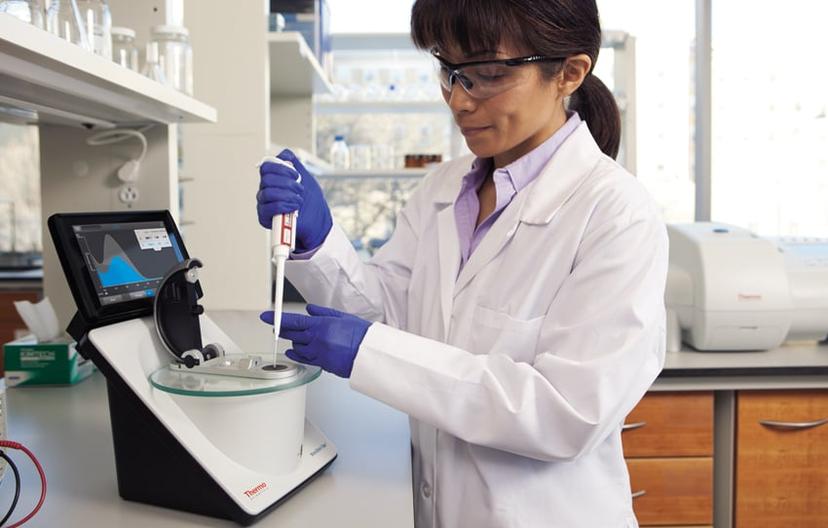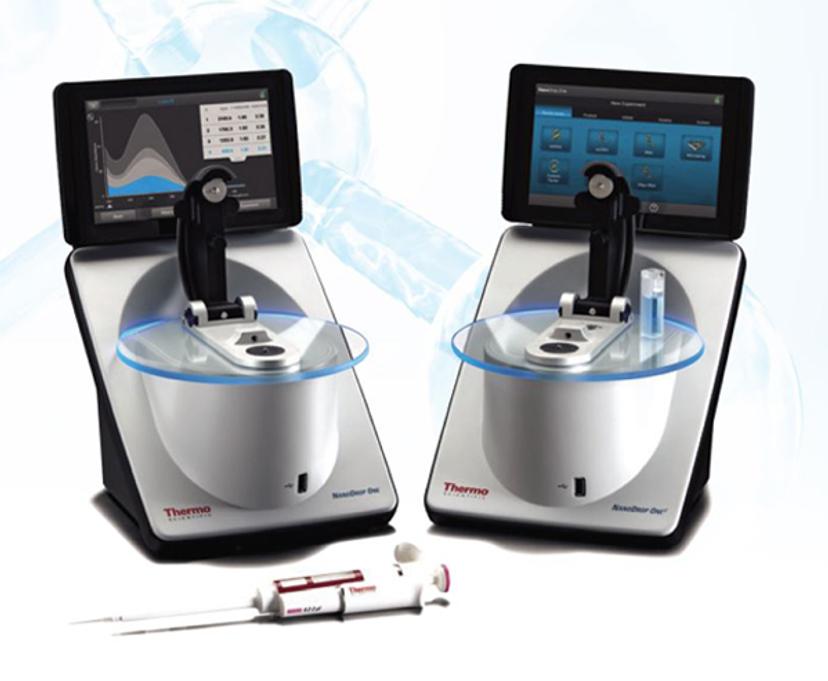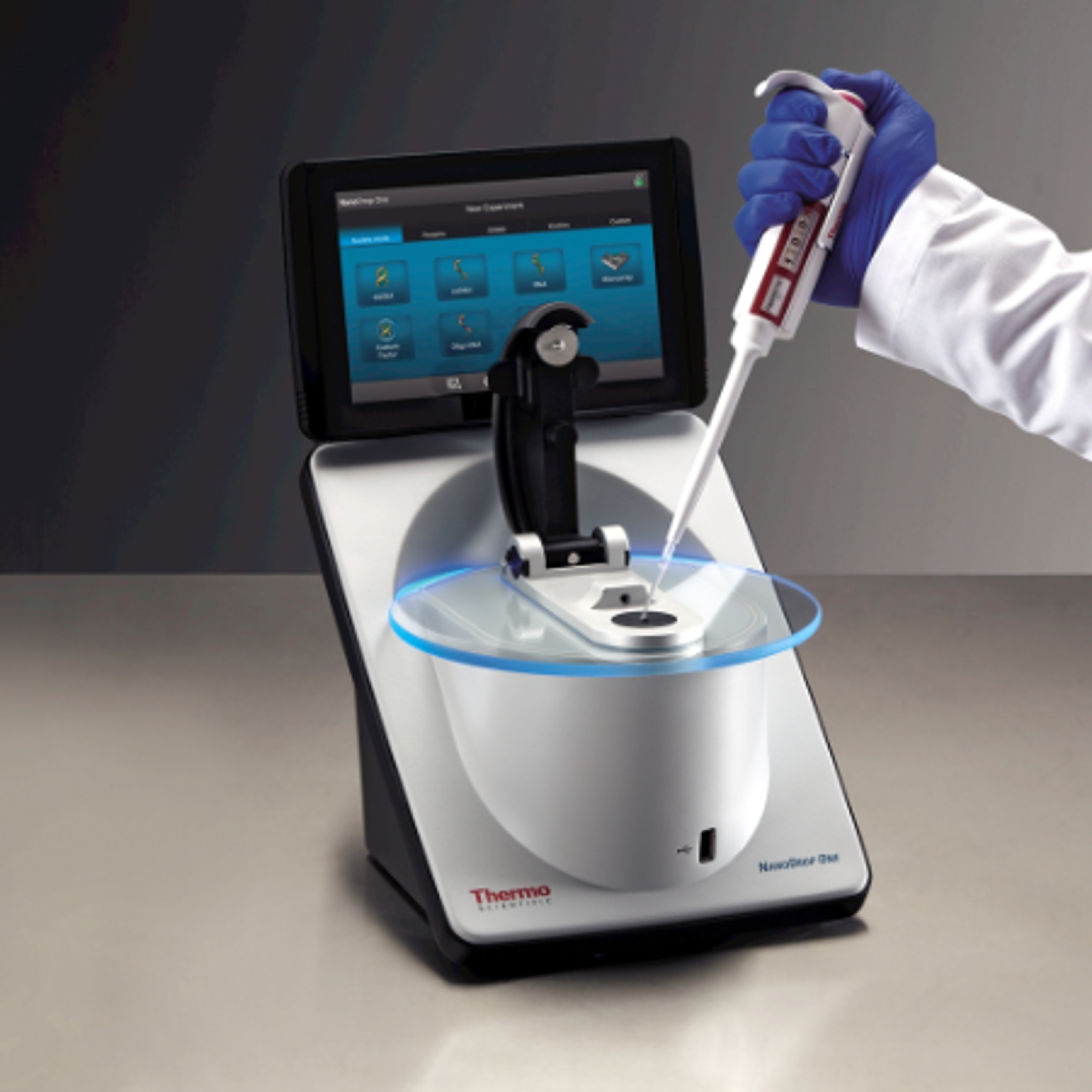The New Thermo Scientific NanoDrop One Spectrophotometer Detects Sample Contamination and Helps Troubleshoot Experiments
The Thermo Scientific™ NanoDrop™ One Microvolume UV-Vis Spectrophotometer was designed to provide scientists with intelligent feedback about nucleic acid and protein samples. Read on, as Dr. Voula Kodoyianni, product manager at Thermo Fisher Scientific, describes its unique features.
18 Sept 2020

SS: Please briefly describe your role at Thermo Fisher Scientific.
VK: I am the product manager for the NanoDrop product line and as such responsible for new product development. Product managers define the features of new products then work with R&D teams to execute. During the development of the NanoDrop One, I was fortunate to work with a group of outstanding mechanical, optical, software and design engineers here at Thermo Fisher Scientific.
SS: The NanoDrop has become an integral part of many wet labs. Can you expand on the history of the NanoDrop?
VK: Over the past eight years Thermo Fisher Scientific has introduced several very well received NanoDrop UV-Vis spectrophotometers: the NanoDrop 2000/2000c was introduced in 2009, the NanoDrop Lite in 2012, and more recently the NanoDrop One in 2015. The NanoDrop One is a stand-alone instrument, with an expanded dynamic range, a high resolution touchscreen interface and enhanced connectivity. Last but not least, with the NanoDrop One we introduce the Thermo Scientific™ Acclaro™ Sample Intelligence technology that gives scientists information about sample purity, so they can make informed decisions on how to use the sample in downstream applications.

SS: What are the key benefits of the NanoDrop One compared to the others?
VK: The NanoDrop One delivers everything that life scientists have come to love about the NanoDrop 1000 and NanoDrop 2000, plus a lot more. It still delivers fast and easy answers from only 1-2 mL per sample. As a stand-alone instrument with a high-resolution touchscreen interface and Automeasure capability, the NanoDrop One is even faster and easier to use. The NanoDrop One's expanded dynamic range (up to 27,500 ng/µl for ds DNA) ensures that users essentially never have to make a dilution just to evaluate their sample. With a new modern design, advanced connectivity and software especially designed for the needs of life science labs, the NanoDrop One offers a high quality experience. We have also added new features for the evaluation of protein samples.
I would also like to mention the advanced connectivity of the NanoDrop One. Users can export data to a PC or Network via USB, Ethernet, or Wi-Fi. On their PC, they can view the full-data formats (including contaminant analysis spectra and information) and organize and analyze their results using the NanoDrop One PC Viewer Software. Users can print results to external printers from the NanoDrop One local control. NanoDrop One instruments can be connected to Thermo Fisher Connect's cloud-based platform, allowing data to be exported directly to Thermo Fisher Cloud for storage. Users can then access their data anytime, anywhere from any device (Android-based or iOS-based devices, PC or Mac desktop computers).

The latest version of the NanoDrop One can do more than just measure concentration of your samples
SS: How does the inbuilt Acclaro Technology help scientists making measurements on the NanoDrop One?
VK: There are three key features to the Acclaro Sample Intelligence Technology.
First, Acclaro uses powerful mathematical algorithms to identify contaminants (such as phenol and guanidine salts) in nucleic acid and protein samples and reports corrected concentrations. This is a sophisticated, chemometric approach that relies on a reference library of spectra.
Second, Acclaro flags problem samples with information alerts and delivers on-demand technical support and guided troubleshooting. For example, it will flag a sample with an A260/A230 ratio outside the acceptable limits and offer information on what contaminants may be responsible for the low ratio value.
Third, Acclaro ensures measurement integrity with an embedded sensor and digital image analysis that monitors for broken columns and bubbles in the sample column
The Acclaro technology helps scientists understand their samples so they can make informed decisions on sample use in experiments. As a result, our customers can perform successful experiments and avoid the costly delays of troubleshooting downstream applications.
SS: What is the most frequently asked question about the NanoDrop One?
VK: Customers often ask whether Acclaro can really identify contaminants in samples. For example, when it detects phenol in their DNA sample, they wonder how it does it. As I mentioned earlier, Acclaro uses mathematical algorithms that rely on reference spectra to identify contaminants and quantify their contribution to the overall absorbance of the sample.
I recently visited a customer in Asia who had a hard time obtaining good microarray data. Then he evaluated his RNA on the NanoDrop One and Acclaro detected guanidine salts in his samples. He re-purified his samples and was able to obtain excellent microarray data. He was very happy. “How do you guys do this?” he asked. “How do you know it has guanidine contamination?”
SS: What can scientists do now with the NanoDrop One that they couldn’t do before?
VK: We’ve worked hard on the protein applications. Protein concentration is typically measured at an absorbance of 280 nm, however to get an accurate concentration at 280 nm, proteins need to have tryptophan and tyrosine residues and not all peptides do. So we have added an A205 application that quantifies protein samples using absorbance of the peptide backbone which all proteins have. We also added a Protein Editor which allows scientists to customize the A280 application on their instrument for the particular proteins that they study. Acclaro can detect DNA contamination in protein samples and correct the A280 result. Also included are methods for four different protein colorimetric assays.
SS: Are there any unique, new fields where the NanoDrop One has been used?
VK: Most of our customers are life scientists but NanoDrop One is a UV-Vis spectrophotometer that can measure absorbance from 190 nm to 850 nm. We have customers in the textile industry for example who measure dye concentration with a NanoDrop One spectrophotometer. Before using the NanoDrop One, they needed to perform sample dilutions in order to make measurements with a conventional spectrophotometer. Dilutions introduce errors and, ultimately, they ended up with different shades than they intended. With the huge dynamic range offered by the NanoDrop One, color shades are reproducible. We also have custom methods for the evaluation of samples that contain gold nanoparticles, chlorophyll, hemoglobin or glucose.
SS: What do you see for the future of this product?
VK: We continue to enhance the NanoDrop One software capability. In the future, we see developments for more application areas and more protein assays. In addition, we will be performing more research to further populate the list of common sample contaminants that Acclaro identifies for our many customers.
SS: What is the next big step for spectrophotometers?
VK: The development of more portable instruments with a smaller footprint. The introduction of spectrophotometers that are perfected for one specific analysis that can perform one measurement really, really well such as the Thermo Scientific AquaMate™, which is a spectrophotometer designed for water analysis. Lastly, connectivity is the next big wave now. Customers want to access data anytime and anywhere. Share data between colleagues who do not have an instrument and view NanoDrop One data across multiple Thermo Fisher Cloud-connected accounts. Thermo Fisher Connect lets you do just that with its cloud service connecting data from multiple instruments of a workflow.

